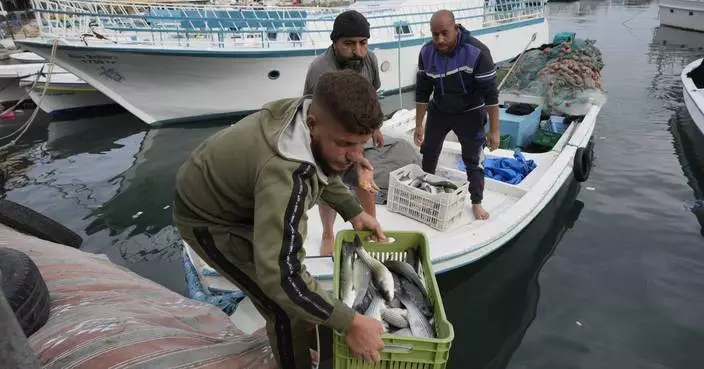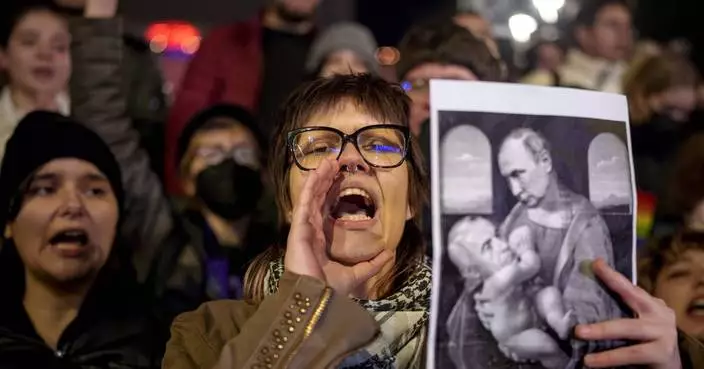BUSAN, South Korea (AP) — The world’s nations will wrap up negotiating a treaty this weekend to address the global plastic pollution crisis.
Their meeting concludes Sunday or early Monday in Busan, South Korea, where many environmental organizations have also flocked to push for a treaty to address the volume of production and toxic chemicals used in plastic products.
Click to Gallery
People pass by an electric display board calling for a reduction in plastic production near the venue for the fifth session of the Intergovernmental Negotiating Committee on Plastic Pollution in Busan, South Korea, Saturday, Nov. 30, 2024. (AP Photo/Ahn Young-joon)
A display board shows a call for a reduction in plastic production during the fifth session of the Intergovernmental Negotiating Committee on Plastic Pollution, at a taxi station in Busan, South Korea, Saturday, Nov. 30, 2024. (AP Photo/Ahn Young-joon)
A screen shows Greenpeace activists boarding a tanker on Saturday, to demand that nations agree to reduce plastic production, during a press conference of Greenpeace at the fifth session of the Intergovernmental Negotiating Committee on Plastic Pollution in Busan, South Korea, Saturday, Nov. 30, 2024. (AP Photo/Ahn Young-joon)
Graham Forbes, Greenpeace Head of Delegation to the Global Plastics Treaty Negotiations, speaks during a press conference at the fifth session of the Intergovernmental Negotiating Committee on Plastic Pollution in Busan, South Korea, Saturday, Nov. 30, 2024. (AP Photo/Ahn Young-joon)
Juan Benito Marcias, a member of The International Indigenous Peoples' Forum on Plastic, speaks during a press conference at the fifth session of the Intergovernmental Negotiating Committee on Plastic Pollution in Busan, South Korea, Saturday, Nov. 30 2024. (AP Photo/Ahn Young-joon)
Juan Carlos Monterrey, right, head of Panama's delegation, speaks before a press conference of members of The International Indigenous Peoples' Forum on Plastics at the fifth session of the Intergovernmental Negotiating Committee on Plastic Pollution in Busan, South Korea, Saturday, Nov. 30, 2024. (AP Photo/Ahn Young-joon)
Members of The International Indigenous Peoples' Forum on Plastics attend a press conference at the fifth session of the Intergovernmental Negotiating Committee on Plastic Pollution in Busan, South Korea, Saturday, Nov. 30, 2024. (AP Photo/Ahn Young-joon)
Greenpeace said it escalated its pressure Saturday by sending four international activists to Daesan, South Korea, who boarded a tanker headed into port to load chemicals used to make plastics.
Graham Forbes, who leads the Greenpeace delegation in Busan, said the action is meant to remind world leaders they have a clear choice: Deliver a treaty that protects people and the planet, or side with industry and sacrifice the health of every living person and future generations.
Here’s what to know about plastics:
The use of plastics has quadrupled over the past 30 years. Plastic is ubiquitous. And every day, the equivalent of 2,000 garbage trucks full of plastic are dumped into the world’s oceans, rivers and lakes, the UN said. Most nations agreed to make the first global, legally binding plastic pollution accord, including in the oceans, by the end of 2024.
The production and use of plastics globally is set to reach 736 million tons by 2040, according to the intergovernmental Organisation for Economic Co-operation and Development.
Panama is leading an effort to address the exponential growth of plastic production as part of the treaty, supported by more than 100 countries. There’s just too much plastic, said Juan Carlos Monterrey, head of Panama’s delegation.
“If we don’t have production in this treaty, it is not only going to be horribly sad, but the treaty may as well be called the greenwashing recycling treaty, not the plastics treaty,” he said in an interview. “Because the problem is not going to be fixed.”
China was by far the biggest exporter of plastic products in 2023, followed by Germany and the U.S., according to the Plastics Industry Association.
Together, the three nations account for 33% of the total global plastics trade, the association said.
The United States supports having an article in the treaty that addresses supply, or plastic production, a senior member of the U.S. delegation told The Associated Press Saturday.
Less than 10% of plastics are recycled. Most of the world’s plastic goes to landfills, pollutes the environment, or is burned.
Sarah Dunlop, head of plastics and human health at the Minderoo Foundation, said chemicals are leaching out of plastics and “making us sick.”
The International Indigenous Peoples Forum on Plastics held an event about the impact of plastics Saturday on the sidelines of the talks. They want the treaty to fully recognize their rights, and the universal human right to a healthy, clean, safe and sustainable environment. Juan Mancias of the Carrizo/Comecrudo Nation in Texas spoke about feeling a spiritual connection to the land.
“Five hundred years ago, we had clean water, clean air and there was no plastics,” he said. “What happened?”
About 40% of all plastics are used in packaging, according to the UN. This includes single-use plastic food and beverage containers — water bottles, takeout containers, coffee lids, straws and shopping bags — that often end up polluting the environment.
U.N. Environment Program Executive Director Inger Andersen told negotiators in Busan the treaty must tackle this problem.
“Are there specific plastic items that we can live without, those that so often leak into the environment? Are there alternatives to these items? This is an issue we must agree on,” she said.
The Associated Press’ climate and environmental coverage receives financial support from multiple private foundations. AP is solely responsible for all content. Find AP’s standards for working with philanthropies, a list of supporters and funded coverage areas at AP.org.
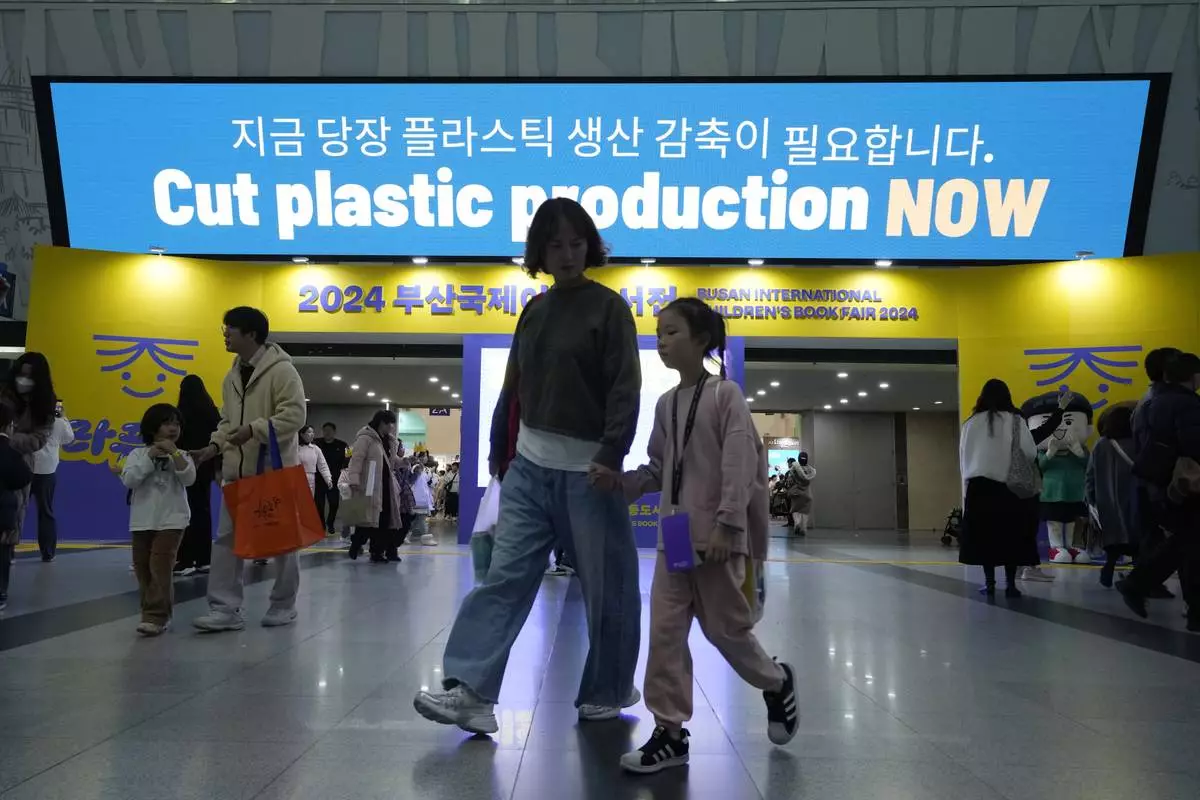
People pass by an electric display board calling for a reduction in plastic production near the venue for the fifth session of the Intergovernmental Negotiating Committee on Plastic Pollution in Busan, South Korea, Saturday, Nov. 30, 2024. (AP Photo/Ahn Young-joon)
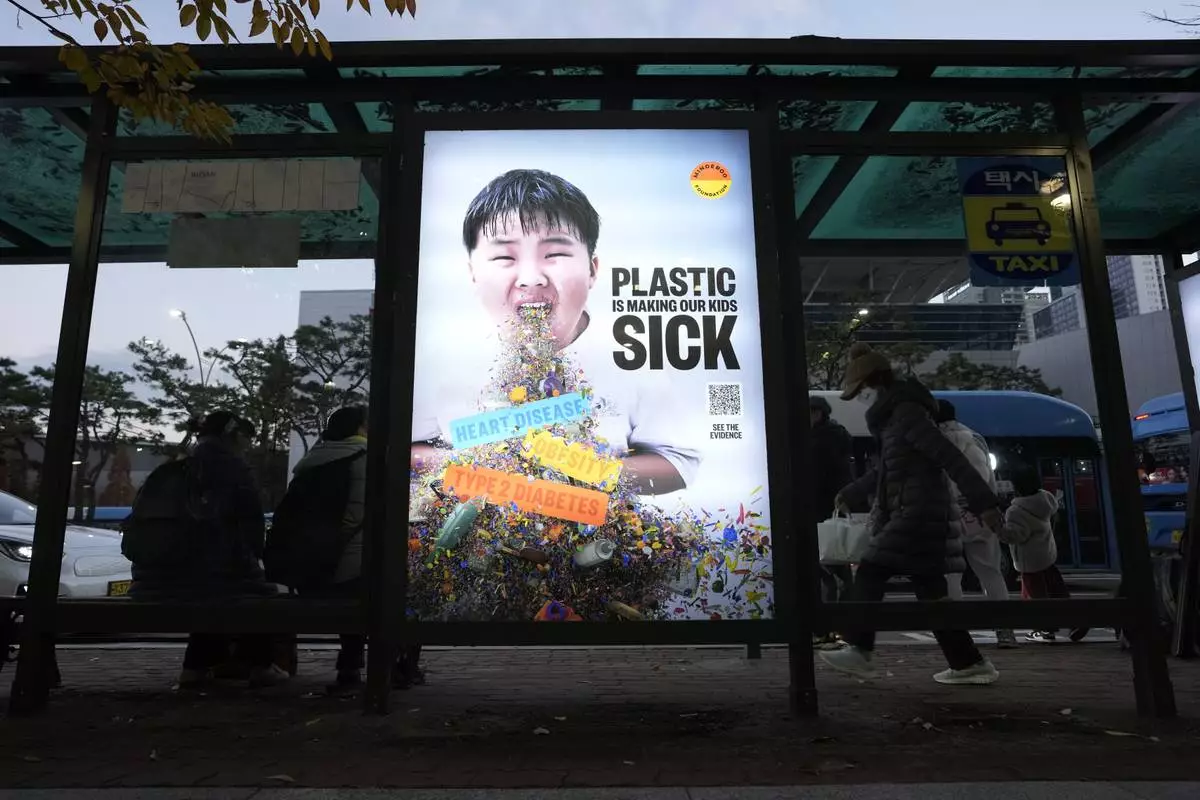
A display board shows a call for a reduction in plastic production during the fifth session of the Intergovernmental Negotiating Committee on Plastic Pollution, at a taxi station in Busan, South Korea, Saturday, Nov. 30, 2024. (AP Photo/Ahn Young-joon)
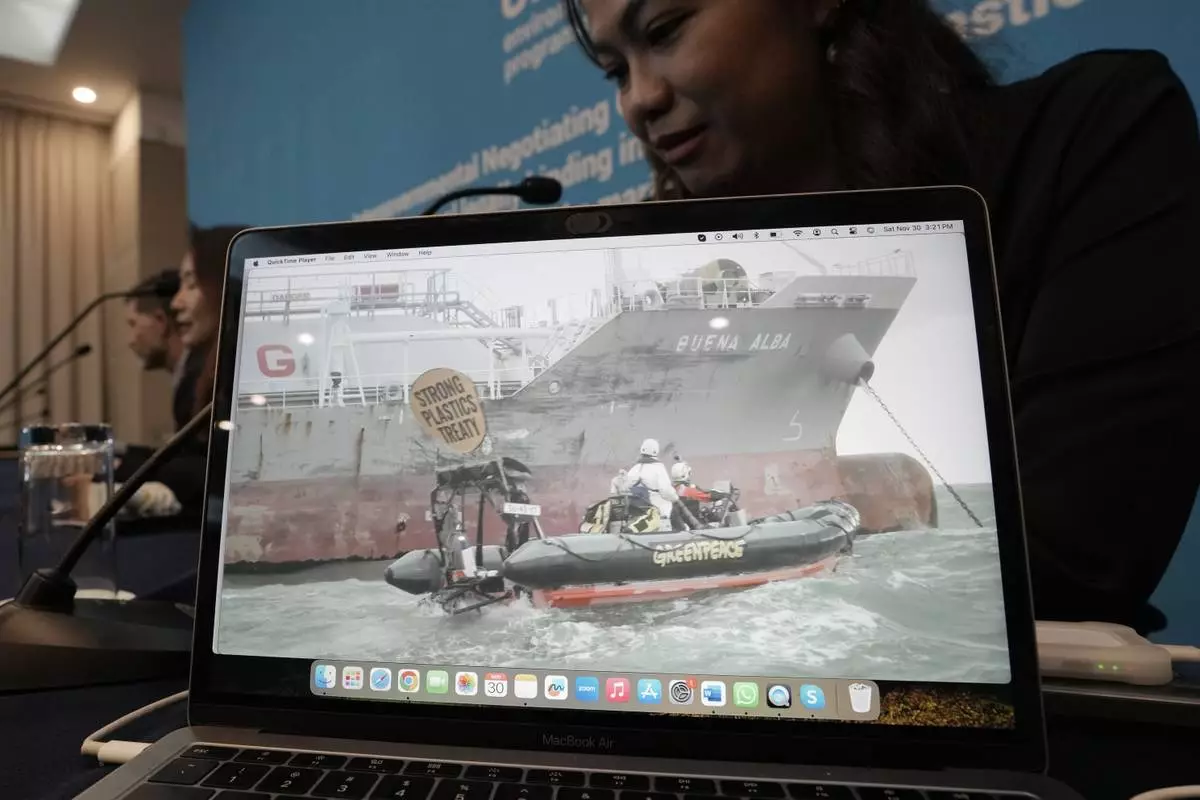
A screen shows Greenpeace activists boarding a tanker on Saturday, to demand that nations agree to reduce plastic production, during a press conference of Greenpeace at the fifth session of the Intergovernmental Negotiating Committee on Plastic Pollution in Busan, South Korea, Saturday, Nov. 30, 2024. (AP Photo/Ahn Young-joon)
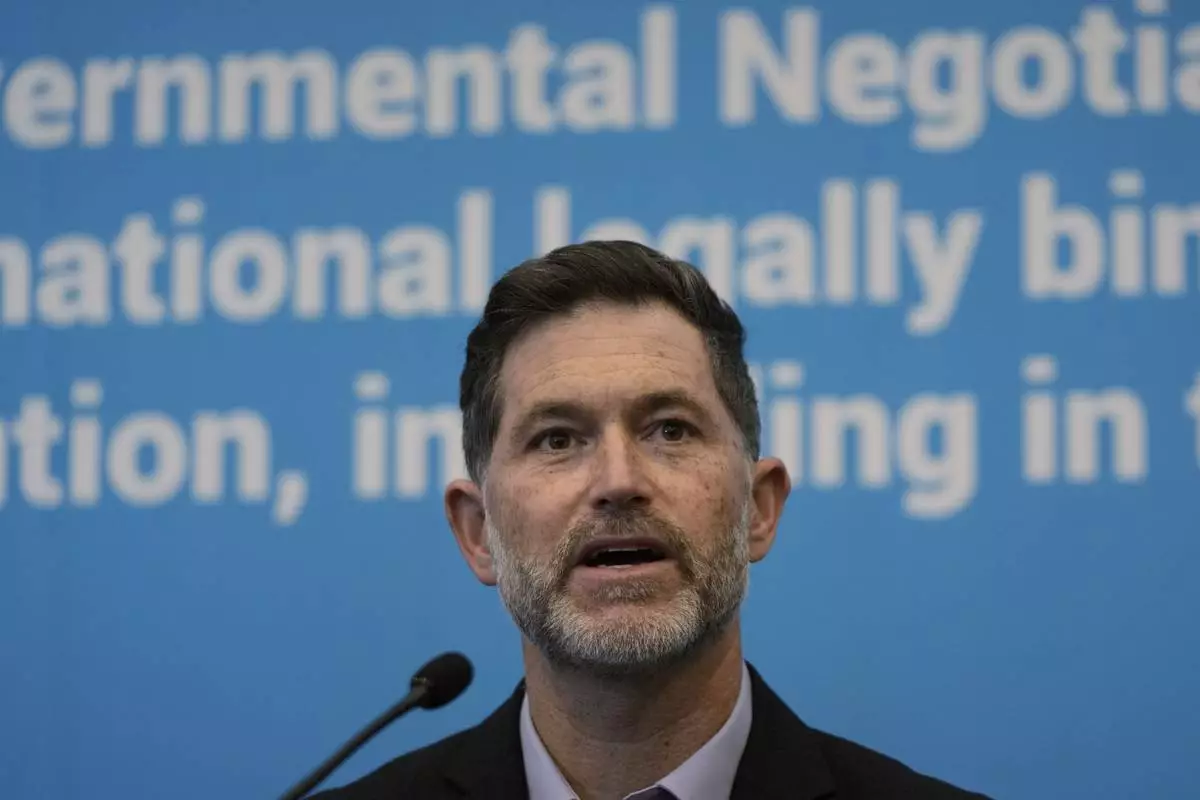
Graham Forbes, Greenpeace Head of Delegation to the Global Plastics Treaty Negotiations, speaks during a press conference at the fifth session of the Intergovernmental Negotiating Committee on Plastic Pollution in Busan, South Korea, Saturday, Nov. 30, 2024. (AP Photo/Ahn Young-joon)

Juan Benito Marcias, a member of The International Indigenous Peoples' Forum on Plastic, speaks during a press conference at the fifth session of the Intergovernmental Negotiating Committee on Plastic Pollution in Busan, South Korea, Saturday, Nov. 30 2024. (AP Photo/Ahn Young-joon)
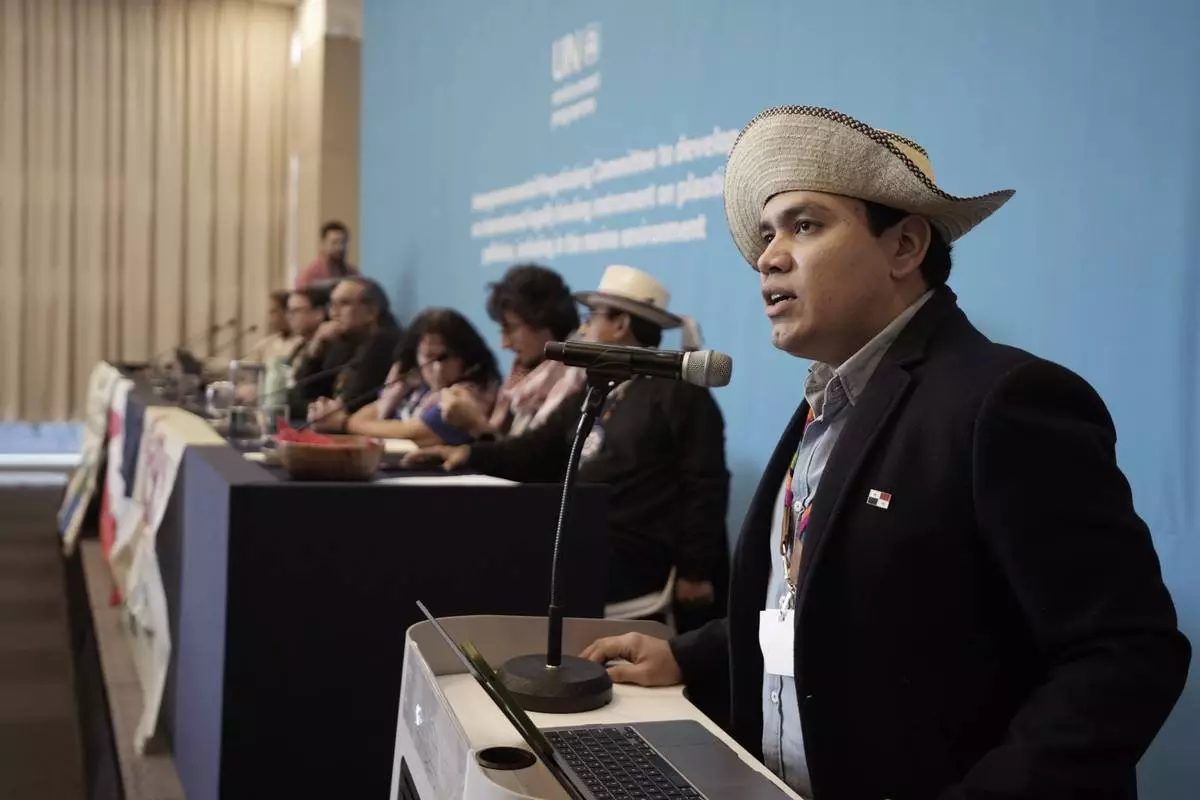
Juan Carlos Monterrey, right, head of Panama's delegation, speaks before a press conference of members of The International Indigenous Peoples' Forum on Plastics at the fifth session of the Intergovernmental Negotiating Committee on Plastic Pollution in Busan, South Korea, Saturday, Nov. 30, 2024. (AP Photo/Ahn Young-joon)

Members of The International Indigenous Peoples' Forum on Plastics attend a press conference at the fifth session of the Intergovernmental Negotiating Committee on Plastic Pollution in Busan, South Korea, Saturday, Nov. 30, 2024. (AP Photo/Ahn Young-joon)
VIACHA, Bolivia (AP) — In the huddled markets, sprawling farms and pulsing parties of Viacha, a town southeast of Bolivia’s capital, it's typical for women to sport bowler hats, tiered skirts and fringed shawls.
What's less typical is for the fashion spotlight to turn to these outfits — worn by “Cholas,” Indigenous women from the highland Altiplano.
But late Friday in Viacha, some 22 kilometers (13 miles) from Bolivia's capital of La Paz — over 12,000 feet (3,650 meters) above sea level — awe-struck teenage boys and proud mothers throbbed the main square as the town’s dirt roadway was briefly transformed into a runway.
One by one, the girls from Viacha — mostly students between 15-25 years old — strutted down the catwalk to a surprising soundtrack of early 2000s American pop music. Street vendors hawked hot dogs and empanadas. Supporters cheered in Spanish and the Indigenous Aymaran language.
Wearing glittering shoes and brightly colored, bunched-out skirts called “polleras,” the amateur models of all heights and sizes twirled, tipped their hats and threw sultry glances at the crowd.
“Years ago, people would associate these skirts with the fields, they'd look down on us as rural peasants,” said Rogelia Canaviri, 42, who couldn't stop smiling as she watched her daughter, Carolina, stride down the runway in dangling pearl earrings, the sequins on her layer-cake red skirt catching the stage lights.
“It's something I'm proud of, to see my daughter and her friends enjoy what I've worn for work my whole life," she said, pointing to the wool shawl, velvet hat and lower-key beige pollera she had on — the same clothes, she said, she still wears to milk her cows and sell her cheese at open-air markets. Her own mother did the same.
Generations ago, the Aymara were subject to waves of conquest and dispossession, first by the Inca, then by the Spanish, who forced the Indigenous communities to abandon their traditional way of dressing and adopt the style then-popular in the court of Seville.
Legend has it that the jaunty felt bowler hat became critical to the get-up after being introduced by British railway workers in the 1920s.
Bolivia's whiter, more affluent population has used “Chola” — and its diminutive, “Cholita” — as dismissive racial epithets. But in recent decades that stigma has dissipated, with Indigenous Aymara proudly reclaiming the word and younger Bolivians rediscovering the charm of their mothers' and grandmothers' vibrant garments.
“I think the ‘Cholita’ has become something very interesting, very exciting in our current context,” said Brittany Cantuta Valeria, 21, a first-time model, her hat brimmed upward and cheeks flushed a reddish gold.
“We’re now at the point of being respected because of everything that’s been implemented, so I wear this to have fun, to show off, to go to parties and dances. I have nothing to do with working the fields.”
Most of the girls parading onstage Friday, in the show organized by the Viacha municipality, grew up during the tenure of former leftist President Evo Morales (2006-2019), the country’s first-ever Indigenous president whose championing of Bolivia's Indigenous majority earned him fervent support across the cinderblock and adobe homes of the Altiplano.
Morales instituted a new constitution, which, among other things, expanded recognition for Bolivia’s 36 ethnic groups. He promoted the teaching of Indigenous languages and boosted state funding for folkloric arts. More Chola runway shows and beauty contests cropped up, widening the reach of Bolivia's native highland culture.
But fashion fanfare was largely limited to La Paz, the seat of the government. Before Friday, the town of Viacha, like most of the other villages across these austere mountain-rimmed plains, had never taken its turn on the runway.
“I was really nervous but I realized this is the first time for all of us,” said 15-year-old Tomasa Ramirez. “I feel so pretty. Now I know it’s my dream to be a Cholita model.”
With Bolivia's economic crisis closing like a vise on families whose money has diminished in value while the cost of food has doubled, many girls said walking the show was no easy feat.
Top-notch velvet hats and shawls made from vicuña wool with silk fringes can fetch thousands of dollars. Polleras cost a few hundred dollars. Then there's the jewelry — ideally made of real gold, pearls and diamonds when worn to these kinds of formal events.
“This year there was no way I could have real ones,” said Julieta Mamani, 16, pointing to her gold-colored earrings. “I hope things will be different next year.”
Watching her 24-year-old daughter pose for selfies in her elaborate skirt, Canaviri, the dairy farmer, has another hope.
“I hope she doesn't like wearing pants,” she said of her daughter. “I tried on pants once in my life, and I felt naked. Never again.”

A woman models a creation by a local designer at a Chola fashion show, promoting the Andean style and beauty of Aymara women, in Viacha, Bolivia, Friday, Nov. 29, 2024. (AP Photo/Juan Karita)

A woman models a creation by a local designer at a Chola fashion show, promoting the Andean style and beauty of Aymara women, in Viacha, Bolivia, Friday, Nov. 29, 2024. (AP Photo/Juan Karita)

Women model creations by a local designer at a Chola fashion show, promoting the Andean style and beauty of Aymara women, in Viacha, Bolivia, Friday, Nov. 29, 2024. (AP Photo/Juan Karita)

Women model creations by a local designer at a Chola fashion show, promoting the Andean style and beauty of Aymara women, in Viacha, Bolivia, Friday, Nov. 29, 2024. (AP Photo/Juan Karita)

Women model creations by a local designer at a Chola fashion show, promoting the Andean style and beauty of Aymara women, in Viacha, Bolivia, Friday, Nov. 29, 2024. (AP Photo/Juan Karita)

A woman models a creation by a local designer at a Chola fashion show, promoting the Andean style and beauty of Aymara women, in Viacha, Bolivia, Friday, Nov. 29, 2024. (AP Photo/Juan Karita)

A woman models a creation by a local designer at a Chola fashion show, promoting the Andean style and beauty of Aymara women, in Viacha, Bolivia, Friday, Nov. 29, 2024. (AP Photo/Juan Karita)



























